Step-by-Step Guide to Automating Call Center Processes

Call center automation is transforming how businesses operate. It enables faster responses, reduces costs, and improves customer satisfaction. For instance, 80% of call centers now use AI-based technologies, while 70% of inquiries will likely be AI-handled by 2024. Automation also cuts costs significantly, with self-service interactions costing just $0.10 compared to $8 for live agent calls. Sobot, a leader in call center automation solutions, offers tools like the Voicebot, which automates over 90% of interactions. This ensures seamless service while freeing agents to handle complex tasks, elevating both efficiency and customer experience.
Understanding Call Center Automation
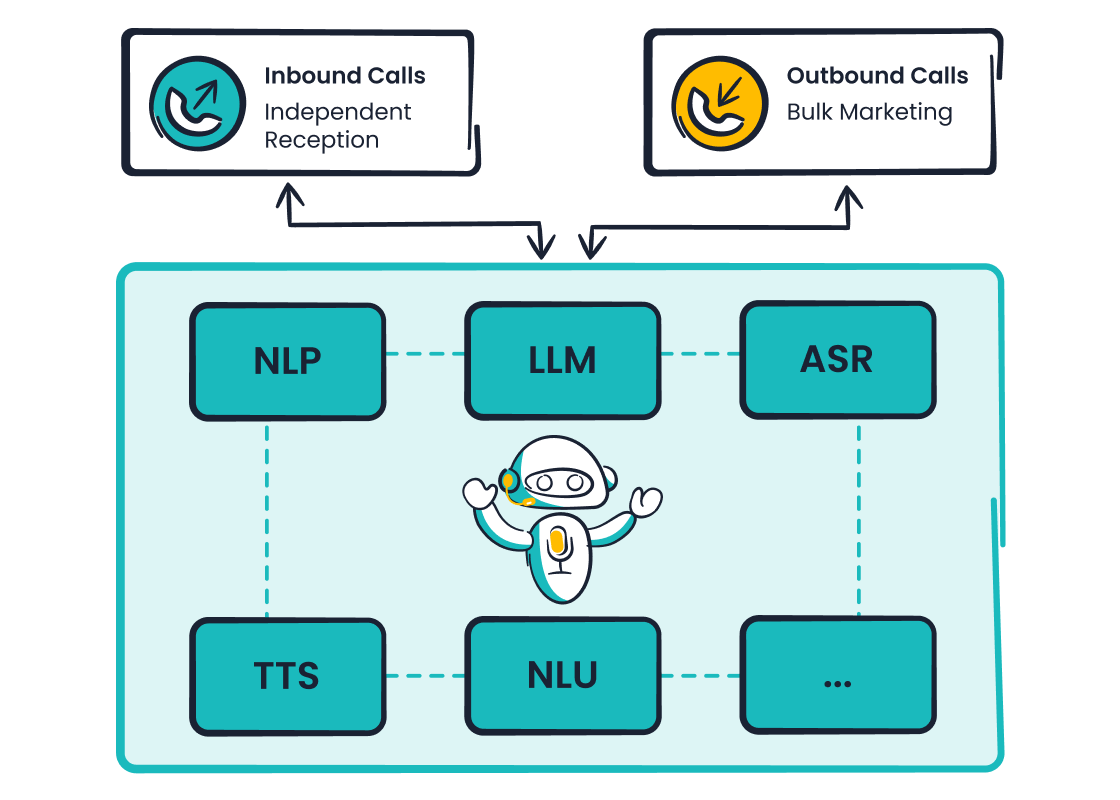
What Is Call Center Automation?
Call center automation refers to the use of technology to streamline and enhance customer service operations. It replaces manual tasks with automated processes, allowing you to handle customer inquiries more efficiently. Over the decades, automation has evolved significantly:
| Year/Decade | Technology Introduced | Description |
|---|---|---|
| 1960s-1970s | Manual Operations | Operators connected calls using switchboards. |
| 1980s | Automatic Call Distributors (ACDs) and IVR | Early forms of call center automation. |
| Early 2000s | Cloud-based Solutions | Enabled flexibility and scalability in call centers. |
| Present | Conversational AI Applications | Provide human-like interactions without human agents. |
Modern call center automation solutions, like those offered by Sobot, go beyond basic automation. They integrate advanced AI technologies to deliver personalized, multilingual, and 24/7 support. This ensures reduced wait times, consistent service, and seamless communication across channels.
Key Components of Call Center Automation
Effective call center automation relies on several key components. These elements work together to improve efficiency and customer satisfaction:
- Forecasting automation: Predicts call volumes and agent needs using historical data.
- Workflow automation: Automates repetitive tasks like data entry and scheduling.
- Automated agent guidance: Provides real-time assistance to agents during customer interactions.
- Sales and marketing automation: Streamlines lead qualification and follow-ups.
- Scheduling automation: Schedules customer calls based on predefined criteria.
- Robotic process automation (RPA): Handles back-office tasks and integrates with CRM systems.
Additionally, tools like interactive voice response (IVR) systems and automatic call distributors (ACDs) simplify call routing. Chatbots and virtual assistants handle basic inquiries, ensuring faster resolutions. By integrating these components, you can create a seamless and efficient contact center automation system.
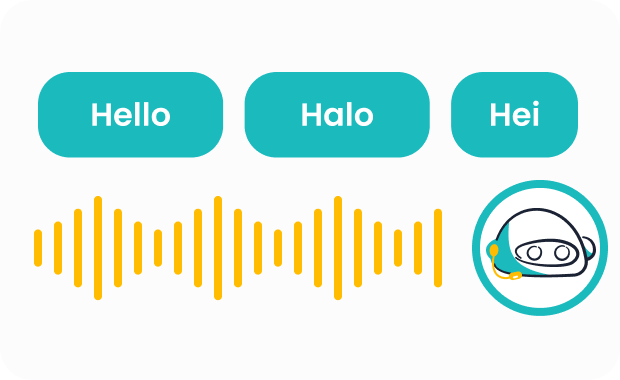
How Sobot Voicebot Enhances Call Center Automation
Sobot Voicebot takes call center automation to the next level. It uses advanced AI technologies, such as natural language processing (NLP) and large language models (LLM), to deliver human-like interactions. This voicebot automates over 90% of customer interactions, significantly reducing costs and improving productivity.
Key features of Sobot Voicebot include:
- Multilingual support: Communicate with customers in their preferred language.
- Seamless integration: Connect with existing CRM and contact center systems effortlessly.
- 24/7 availability: Provide uninterrupted support, even during peak hours.
- Personalized interactions: Tailor responses based on customer data and preferences.
For example, Sobot Voicebot can handle both inbound and outbound calls. It automates identification and verification processes, ensuring smooth transitions to human agents when necessary. This combination of automation and human collaboration enhances the overall customer experience. Businesses like OPPO have already seen remarkable results, such as an 83% chatbot resolution rate and a 57% increase in repurchase rates, by leveraging Sobot’s solutions.
Benefits of Call Center Automation Solutions
Boosting Efficiency and Productivity
Call center automation transforms how you manage customer service operations. By automating workflows, you can eliminate repetitive tasks like data entry and scheduling, freeing up agents to focus on complex customer interactions. This shift leads to measurable improvements in productivity. For example, businesses report a 20% increase in sales and customer service efficiency and save up to 20 hours per month per employee. Additionally, automation tools enhance agent productivity by identifying opportunities for optimization, ensuring your team operates at peak performance.
Workflow automation also improves intelligent call routing, ensuring customers connect with the right agent or department. This reduces wait times and boosts first-call resolution rates by 20%, as highlighted by MIT Technology Review. With tools like Sobot Voicebot, you can further streamline operations by automating over 90% of interactions, allowing agents to focus on tasks requiring human expertise.
Reducing Costs Through Automation
Automation significantly reduces operational costs. Self-service options, such as AI-powered chatbots, cost just $0.10 per interaction compared to $8 for live agent calls. This cost-effectiveness makes automation tools indispensable for businesses aiming to optimize their budgets. By automating workflows, you can reduce the need for additional staff during peak periods, saving resources while maintaining service quality.
Sobot Voicebot exemplifies this cost-saving potential. Its multilingual capabilities and 24/7 availability ensure consistent customer service without the need for overtime or additional hires. Businesses using Sobot’s solutions have seen up to a 60% reduction in call abandonment rates, as noted by CFI Group. These savings allow you to reinvest in other areas, driving growth and innovation.
Enhancing Customer Experience with AI-Powered Tools
AI-powered tools elevate the customer experience by providing personalized and efficient service. Features like real-time sentiment analysis help agents understand customer emotions during calls, enabling them to adjust their approach for better outcomes. Surveys show that 80% of consumers prefer companies offering personalized experiences, and 73% consider customer experience crucial in purchasing decisions, according to Epsilon and PwC.
Sobot’s Voicebot enhances interactions by tailoring responses based on customer data and preferences. Its seamless integration with CRM systems ensures agents have access to relevant information, fostering engaging conversations. Businesses leveraging AI-powered chatbots and smart analytics report higher customer satisfaction scores, with improvements of up to 45% related to reduced wait times. These tools not only improve satisfaction but also build loyalty, ensuring customers return for future purchases.
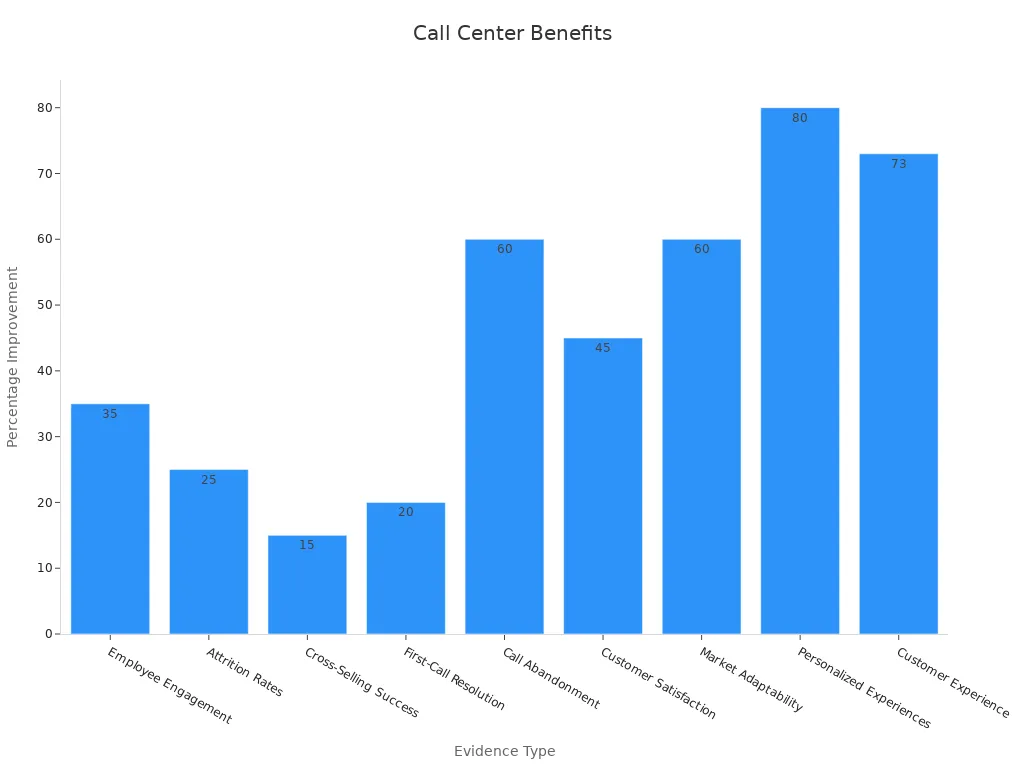
Scalability and Flexibility for Growing Businesses
Call center automation solutions empower businesses to scale operations effortlessly while maintaining service quality. As your company grows, the ability to handle increasing customer demands becomes crucial. Automated systems adapt to fluctuating call volumes, ensuring consistent performance during peak times. For example, cloud-based contact centers scale operations 30% faster than traditional systems, enabling quicker responses to business growth.
Sobot’s Voicebot exemplifies this scalability. Its cloud-based infrastructure adjusts call volumes within a single business day, ensuring uninterrupted service during high-demand periods. Whether you’re managing seasonal spikes or expanding into new markets, automation tools like Sobot Voicebot provide the flexibility to meet evolving needs. Multilingual capabilities further enhance adaptability, allowing you to serve diverse customer bases without additional resources.
The transition to cloud-based solutions also reduces infrastructure management burdens. By 2025, 55% of call centers will have adopted these technologies, benefiting from lower costs and streamlined operations. Automated systems eliminate the need for manual adjustments, freeing your team to focus on strategic initiatives. This flexibility ensures your business remains agile, ready to scale operations as needed.
| Statistic | Description |
|---|---|
| 55% | By 2025, 55% of call centers will use cloud-based solutions for scalability. |
| Peak Handling | Automated systems handle increased call volumes during peak times seamlessly. |
| 30% Faster | Cloud-based centers scale operations 30% faster than legacy systems. |
Sobot’s omnichannel solutions further enhance flexibility by integrating communication channels into a unified workspace. This approach simplifies customer interactions, ensuring seamless service across voice, email, and social media platforms. With automation, you can scale operations efficiently while maintaining personalized customer experiences.
Step-by-Step Guide to Call Center Automation Integration

Step 1: Assess Your Call Center’s Needs and Goals
Before implementing automation, you need to evaluate your call center’s current state. Start by identifying the challenges your team faces. Are long wait times frustrating customers? Are agents overwhelmed with repetitive tasks? Understanding these pain points will help you set clear goals for automation.
Define measurable objectives. For example, you might aim to reduce average handling time by 20% or improve customer satisfaction scores by 15%. Use performance metrics like call abandonment rates, first-call resolution rates, and agent productivity to assess your call center operations. AI tools, such as speech analytics and sentiment analysis, can provide valuable insights into customer interactions and agent performance. These tools identify improvement opportunities and help you align your goals with customer expectations.
Tip: Involve your team in this assessment. Agents often have firsthand knowledge of inefficiencies and can provide valuable input on areas that need improvement.
Step 2: Identify Processes Suitable for Automation
Not all processes are ideal for automation. Focus on tasks that are repetitive, time-consuming, and prone to human error. Examples include call routing, appointment scheduling, and basic customer inquiries. High-volume tasks, such as order tracking or FAQs, are also excellent candidates for automation.
Use the following criteria to evaluate processes for automation:
| Criteria | Description |
|---|---|
| Employee Involvement | Tasks requiring significant manual effort and repetition. |
| Complexity | Processes with multiple steps that can benefit from automation. |
| Standardization and Stability | Stable and repetitive tasks, especially in back-office functions. |
| Volume | High-volume tasks that can run continuously to enhance efficiency. |
| Outsourcing | Automating outsourced processes to reduce compliance risks. |
For example, Sobot Voicebot automates over 90% of customer interactions, including inbound and outbound calls. It handles identification and verification processes, ensuring seamless transitions to human agents when needed. This approach not only streamlines operations but also improves customer satisfaction by reducing wait times.
Step 3: Choose the Right Call Center Automation Solutions
Selecting the right automation tools is critical for success. Look for solutions that align with your call center’s needs and goals. Consider factors like scalability, integration capabilities, and ease of use. Cloud-based solutions, such as Sobot Voicebot, offer flexibility and can scale quickly to meet growing demands.
Here’s how businesses are adopting automation solutions:
| Key Findings | Percentage |
|---|---|
| Currently evaluating automation solutions | 35% |
| Implementing an automation solution | 32% |
| Already using automation solutions | 16% |
| Planning to adopt an automation solution | 12% |
| Have not adopted and not planning to adopt | 5% |
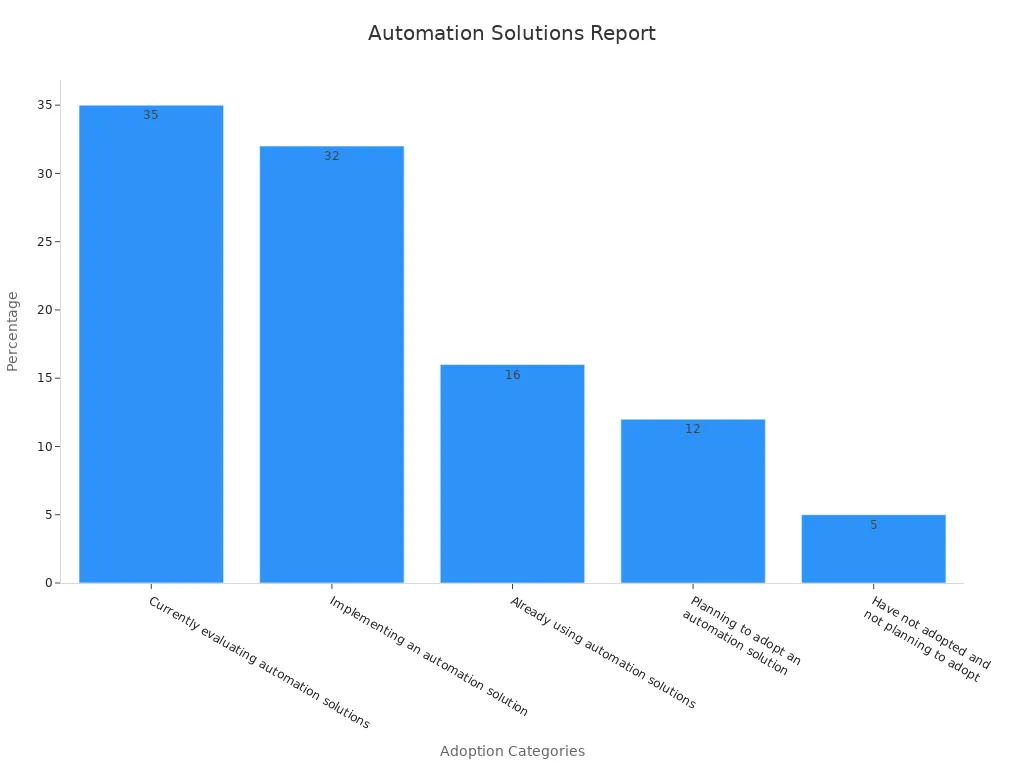
When evaluating solutions, prioritize features like multilingual support, real-time monitoring, and seamless integration with existing systems. Sobot’s Voicebot, for instance, connects effortlessly with CRM platforms and provides 24/7 availability. This ensures uninterrupted service and enhances agent productivity. As Gadi Shamia, CEO of Replicant, states, "Automation has the power to transform the industry, as evidenced by the accelerated adoption of the technology."
Note: Customer satisfaction should remain your top priority. Choose tools that enhance the customer experience while streamlining operations.
Step 4: Integrate Tools Like Sobot Voicebot with Existing Systems
Integrating automation tools like Sobot Voicebot into your existing systems ensures a smooth transition and maximizes efficiency. Start by evaluating your current infrastructure. Identify gaps in your workflows where automation can add value. For example, if your CRM lacks real-time call data, integrating Sobot Voicebot can bridge this gap by providing seamless data synchronization.
Sobot Voicebot offers plug-and-play integration with leading CRM platforms and contact center systems. This feature simplifies the process, allowing you to connect tools without extensive technical expertise. Its API capabilities ensure compatibility with your existing operations, enabling you to automate tasks like call routing, customer identification, and data entry. This integration not only reduces manual effort but also enhances agent productivity by providing real-time insights during customer interactions.
To ensure a successful integration, follow these steps:
- Map Your Processes: Document how your current systems handle customer interactions. Identify areas where automation can streamline operations.
- Test Compatibility: Use sandbox environments to test how Sobot Voicebot interacts with your existing tools.
- Implement Gradually: Start with high-impact areas, such as automating FAQs or outbound marketing calls, before scaling to more complex processes.
- Monitor Performance: Use analytics to track how the integration impacts metrics like call resolution rates and customer satisfaction.
By integrating tools like Sobot Voicebot, you can create a unified contact center automation system that enhances both efficiency and customer satisfaction.
Step 5: Train Your Team for Seamless Adoption
Training your team is essential for the successful adoption of automation tools. Without proper training, even the most advanced systems can fail to deliver their full potential. Focus on equipping your agents with the skills they need to use tools like Sobot Voicebot effectively.
Consider these proven training models:
| Training Model | Description |
|---|---|
| Digital Adoption Platform | Provides in-app learning experiences using videos, slideshows, and PDFs. Analytics help identify friction points, enabling personalized training. |
| Gamification | Engages agents through gaming elements, encouraging them to tackle repetitive tasks creatively. Immediate feedback fosters a deeper understanding of automation workflows. |
| Real-Time AI Coaching | Offers live monitoring and dynamic prompts, helping agents improve performance during customer interactions. |
For example, Sobot Voicebot’s intuitive interface makes it easy for agents to learn its features. Pair this with gamification techniques to make training engaging and effective. You can also use real-time AI coaching to provide agents with actionable insights during live calls, ensuring they adapt quickly to the new system.
Tip: Encourage a culture of continuous learning. Regularly update training materials to reflect new features or changes in workflows. This approach keeps your team aligned with evolving business needs.
Step 6: Monitor, Analyze, and Optimize Performance
Once you’ve implemented automation, monitoring and optimizing its performance becomes crucial. Start by setting measurable objectives. For instance, aim to reduce average call handling time by 15% or increase first-call resolution rates by 20%. Use these goals to guide your analysis.
Performance analytics reports can help you track progress. These reports typically follow a structured process:
| Phase | Description |
|---|---|
| Set Objectives | Define KPIs to measure success, such as customer satisfaction scores or agent productivity metrics. |
| Detect | Identify improvement opportunities by analyzing large datasets for patterns or issues. |
| Analyze | Use techniques like process mining to understand why certain KPIs underperform. |
| Improve | Implement changes to enhance workflows, team performance, or customer interactions. |
| Monitor | Ensure improvements are sustained over time, preventing regression to old habits. |
For example, Sobot Voicebot provides detailed analytics on call volumes, resolution rates, and customer sentiment. Use these insights to identify bottlenecks in your operations. If call abandonment rates remain high, consider optimizing your IVR system or adjusting call routing rules.
Note: Regularly review your automation tools to ensure they align with your business goals. Continuous optimization keeps your contact center agile and responsive to customer needs.
By monitoring, analyzing, and optimizing your automation systems, you can maintain high levels of efficiency and satisfaction while adapting to changing demands.
Overcoming Challenges in Contact Center Automation
Addressing Resistance to Change
Resistance to change often arises when employees feel uncertain about new technologies. You can overcome this by fostering a culture of continuous learning. Provide accessible training opportunities that help your team understand automation tools and their benefits. For example, using digital adoption platforms with in-app tutorials can make learning intuitive and engaging.
Effective communication is another key strategy. Share clear and transparent information about the changes early in the process. Explain how automation will enhance workflows and reduce repetitive tasks, allowing employees to focus on meaningful interactions. Involving your team in decision-making also promotes collaboration and ownership, reducing resistance.
Tip: Highlight success stories from other businesses. For instance, OPPO improved service efficiency and employee satisfaction by integrating Sobot’s solutions, demonstrating the positive impact of automation.
Resolving Integration Issues with Legacy Systems
Legacy systems often pose challenges during automation implementation. Common issues include data format mismatches, lack of API support, and discontinued vendor support. Addressing these requires a methodical approach:
| Compatibility Issue | Description |
|---|---|
| Data Format Mismatch | Outdated formats complicate data migration and integration. |
| Lack of API Support | Older systems may not connect with modern platforms. |
| Vendor Support Discontinuation | Unsupported systems increase operational risks. |
You can resolve these issues by choosing automation tools like Sobot Voicebot, which offer plug-and-play integration with existing systems. Its API capabilities ensure seamless data synchronization, reducing manual effort. Testing compatibility in sandbox environments before full deployment can also prevent disruptions.
Note: Collaborate with IT teams to map processes and identify gaps. This ensures a smoother transition and minimizes downtime during integration.
Balancing Automation with Human Interaction
Automation enhances efficiency, but human interaction remains essential for complex or emotionally charged situations. A balanced approach ensures customer satisfaction while optimizing call center operations.
| Interaction Type | Description | Handling Method |
|---|---|---|
| Automation-First | Handles simple, transactional requests. | Automated systems |
| Human-First | Manages complex or high-value interactions. | Immediate human involvement |
| Hybrid | Combines automation for routine tasks with human support for escalations. | Combination of both |
For example, intent-based routing directs simple queries to automated systems like Sobot Voicebot, while complex issues go to skilled agents. Dynamic self-service options provide quick resolutions but allow escalation paths for unresolved concerns. Additionally, context-preserving transfers ensure seamless handoffs between automation and human agents, maintaining continuity in interactions.
Technologies like AI-powered sentiment analysis and predictive analytics further enhance this balance. These tools help agents respond empathetically and build stronger customer relationships, improving overall satisfaction.
Ensuring Data Security and Compliance
Data security and compliance are critical in call center automation. Automated systems handle sensitive customer information, making it essential to protect data and adhere to regulatory standards. Neglecting these aspects can lead to data breaches, legal penalties, and loss of customer trust.
Key Compliance Standards for Call Centers
Several compliance standards guide businesses in safeguarding customer data. These regulations ensure that your call center automation tools operate securely and ethically:
- HIPAA: Protects sensitive health information in the healthcare sector.
- GDPR: Regulates data protection and privacy for EU citizens.
- CCPA: Safeguards consumer privacy rights in California.
| Compliance Standard | Description |
|---|---|
| PCI DSS | Prevents storage of sensitive cardholder data, reducing risks of breaches. |
| HIPAA | Ensures patient data security by preventing unauthorized access. |
| TCPA | Regulates contact hours and consent, protecting customers from spam calls. |
By adhering to these standards, you can ensure your automated call center solutions meet global security requirements.
Best Practices for Data Security
Implementing robust security measures is vital for protecting customer data. Here are some effective practices:
- Train employees regularly on security protocols and best practices.
- Use automated monitoring tools to detect and prevent suspicious activities.
- Develop a clear incident-response plan to address potential data breaches.
For example, Sobot’s Voicebot integrates seamlessly with existing CRM systems while maintaining high security standards. Its API capabilities ensure data encryption during transfers, reducing risks of unauthorized access. Additionally, Sobot’s omnichannel solutions unify customer interactions across platforms, minimizing data fragmentation and enhancing security.
Tip: Regularly audit your systems to identify vulnerabilities. Proactive monitoring helps you stay ahead of potential threats.
Why Compliance Matters
Compliance not only protects your business but also builds customer trust. Studies show that 84% of consumers are more likely to trust companies that prioritize data security (PwC). By integrating secure automation tools like Sobot Voicebot, you can enhance customer confidence while streamlining operations.
Best Practices for Successful Call Center Automation
Start Small and Scale Gradually
Starting small allows you to test automation tools in a controlled environment. This approach minimizes risks and ensures a smoother transition. Begin by automating simple, repetitive tasks like call routing or FAQs. Once you see positive results, expand automation to more complex processes.
For example, TD Bank implemented AI-powered virtual assistants to handle over 70% of routine inquiries. This gradual approach led to a 25% cost reduction and a 15-point increase in customer satisfaction. Similarly, Delta Airlines used automation for flight changes and rebooking, achieving a 95% resolution rate and a 30% boost in customer satisfaction during disruptions.
| Organization | Implementation Details | Benefits Achieved |
|---|---|---|
| TD Bank | AI-powered virtual assistants handling over 70% of routine inquiries | 25% cost reduction, 15-point increase in customer satisfaction |
| Delta Airlines | Automated system for managing flight changes and rebooking | 95% resolution rate, 30% higher customer satisfaction during disruptions |
Scaling gradually ensures you can adapt to challenges and refine your processes. This method also helps your team adjust to new systems without feeling overwhelmed.
Focus on Customer-Centric Automation
Automation should enhance the customer experience, not replace human interaction entirely. Focus on tools that provide personalized and efficient service. Metrics like First Call Resolution (FCR) and Net Promoter Score (NPS) help measure the success of customer-centric automation.
| KPI | Definition | Related Industries |
|---|---|---|
| First Call Resolution | Measurement of a call center's performance for resolving customer interactions on the first call | Healthcare, Law, Finance, Non-profit |
| Net Promoter Score | Metric for how likely a customer is to recommend a product, service, or company | Finance, Healthcare |
Sobot’s Voicebot excels in this area by tailoring responses based on customer data. Its multilingual support and 24/7 availability ensure customers receive timely and relevant assistance. By automating over 90% of interactions, Sobot Voicebot reduces wait times and improves satisfaction. This balance between automation and human support creates a seamless experience for your customers.
Leverage Sobot’s Omnichannel Solutions for Unified Operations
Unified operations simplify customer interactions across multiple channels. Sobot’s omnichannel solutions integrate voice, email, and social media into a single platform. This approach reduces inbound discussion volume by 20% and increases customer satisfaction rates to 97%.
| Metric | Value |
|---|---|
| Reduction in inbound discussion volume | 20% |
| Customer satisfaction rate | 95% |
| Problem resolution rate | 85% |
| Customer happiness rate | 99% |
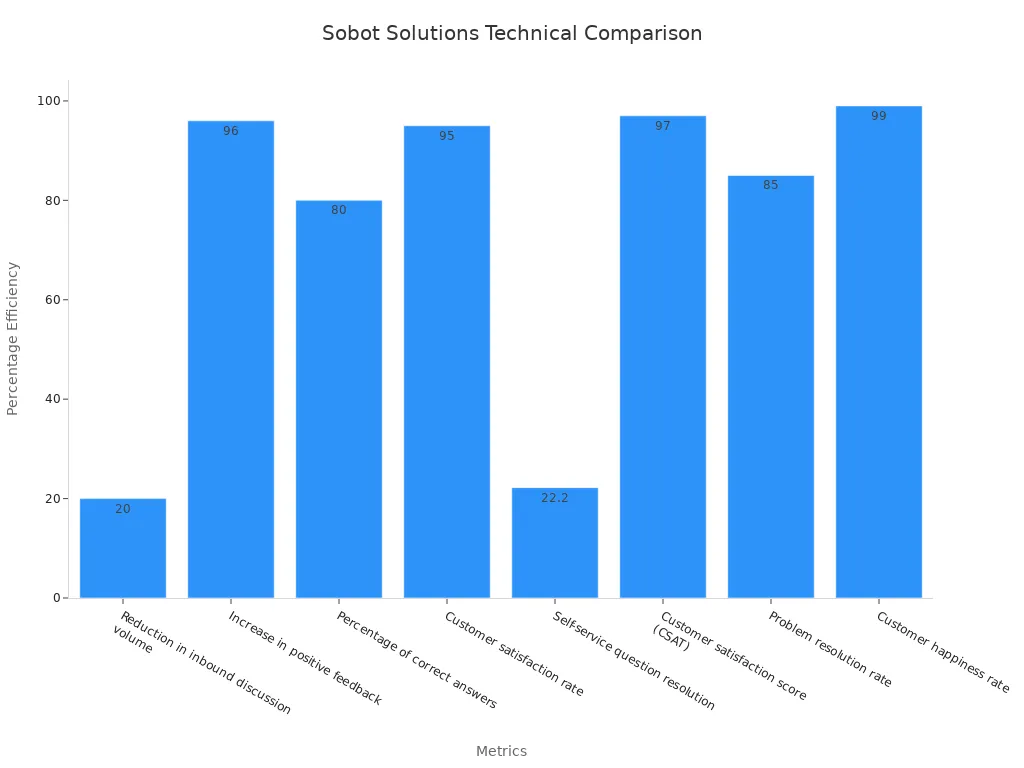
These solutions also provide analytics to monitor performance and identify areas for improvement. By leveraging Sobot’s tools, you can unify operations, enhance efficiency, and deliver a superior customer experience.
Continuously Review and Update Automation Strategies
Call center automation is not a one-time implementation. To stay competitive, you must regularly review and refine your automation strategies. Customer expectations, technology, and business needs evolve constantly. Without updates, your automation tools may fall behind, leading to inefficiencies and customer dissatisfaction.
Start by analyzing performance metrics. Tools like Sobot Voicebot provide detailed analytics on call resolution rates, customer sentiment, and agent productivity. Use these insights to identify areas needing improvement. For example, if customer satisfaction scores drop, investigate whether your automated responses align with customer needs. Regularly updating your automation workflows ensures they remain effective and relevant.
Tip: Schedule quarterly reviews of your automation systems. This proactive approach helps you address issues before they impact customer experience.
Incorporate customer feedback into your updates. Surveys and sentiment analysis can reveal gaps in your automation processes. For instance, if customers frequently escalate calls to human agents, it may indicate that your voicebot needs better training or expanded capabilities. Sobot Voicebot’s learning-driven builder allows you to refine conversation flows easily, ensuring continuous improvement.
Stay informed about advancements in automation technology. Emerging trends like AI-driven sentiment analysis and predictive analytics can enhance your call center’s capabilities. Adopting these innovations keeps your operations ahead of the curve. Sobot’s omnichannel solutions, for example, integrate seamlessly with new technologies, enabling you to scale and adapt effortlessly.
Note: Regular updates not only improve efficiency but also build customer trust. A well-maintained system demonstrates your commitment to delivering exceptional service.
By continuously reviewing and updating your call center automation strategies, you ensure long-term success. This approach keeps your operations efficient, your customers satisfied, and your business ready for future challenges.
Call center automation transforms customer service operations. It boosts efficiency, reduces costs, and enhances customer satisfaction. Following the outlined steps ensures a smooth integration process, from assessing needs to optimizing performance. Balancing automation with human interaction remains crucial for personalized experiences.
- Automated evaluations improve agent performance but require human insight for coaching.
- Managers use data to create personalized feedback and development plans, fostering engagement and growth.
Sobot’s solutions, like Voicebot, combine AI-driven automation with seamless human collaboration. Explore these tools to elevate your call center and deliver exceptional customer experiences.
FAQ
What is the role of AI in modern call centers?
AI plays a transformative role in call centers by automating repetitive tasks, analyzing customer sentiment, and providing real-time assistance. AI-driven tools like Sobot Voicebot handle over 90% of interactions, reducing costs and improving efficiency. This ensures faster resolutions and enhances the overall customer experience.
Can automation replace human agents in call centers?
Automation complements, rather than replaces, human agents. Tools like Sobot Voicebot handle routine inquiries, allowing agents to focus on complex issues. This hybrid approach balances efficiency with personalized service, ensuring customers receive the best of both worlds.
How does call center automation improve customer satisfaction?
Automation reduces wait times, provides 24/7 support, and ensures consistent service. For example, automated customer service tools like Sobot Voicebot offer multilingual support and personalized interactions. Businesses using such tools report up to a 45% increase in customer satisfaction scores.
What processes are ideal for automation in a call center?
Repetitive and high-volume tasks, such as call routing, appointment scheduling, and FAQs, are ideal for automation. Sobot Voicebot excels in automating these processes, ensuring seamless transitions to human agents when needed. This improves efficiency and reduces operational costs.
Is call center automation scalable for growing businesses?
Yes, automation adapts to fluctuating call volumes, making it ideal for scaling operations. Cloud-based solutions like Sobot Voicebot adjust call handling within a single business day. This ensures consistent performance during peak times and supports business growth.
See Also
Understanding The Efficiency Of Call Center Automation
A Comprehensive Guide To Omnichannel Contact Center Setup
Exploring Effective Omnichannel Software For Call Centers
